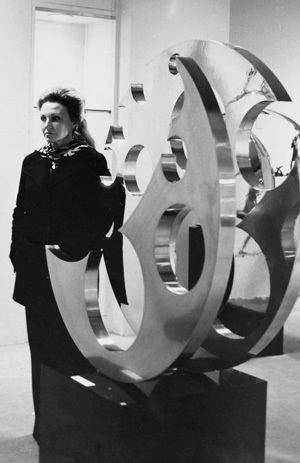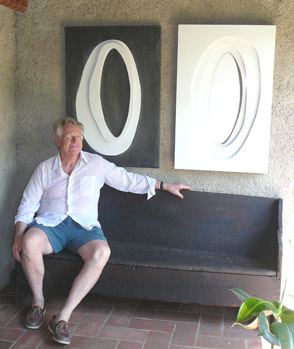Nationality Italian-American Name Carla Lavatelli | Role Artist | |
Died January 18, 2006, Camaiore, Italy | ||
Carla Lavatelli - Happening for Peace: Part 1
Carla Lavatelli (August 21, 1928 – January 18, 2006) was an Italian-American artist whose career spanned five decades, from the 1950s into the 21st century. Her work resides in the permanent collections of several major museums, including the San Francisco Museum of Art, the Phillips Collection in Washington DC, the Hakone Open-Air Museum in Japan, and the Cantor Arts Center at Stanford University. She was noted primarily for her abstract sculptures in stone and bronze, which appeared in reproduction in such publications as Arts Magazine, Art in America, and Artforum during the late 1960s and early 1970s.
Contents
- Carla Lavatelli Happening for Peace Part 1
- Carla Lavatelli 140 Thompson St NYC Part 1
- Biography
- Exhibitions
- Collections
- Notable works by Carla Lavatelli
- One Woman exhibitions
- Honors and accomplishments
- References
Carla Lavatelli - 140 Thompson St., NYC: Part 1
Biography

Carla Lavatelli was born in Rome, Italy in 1928 and spent much of her childhood being raised in Africa. She returned to Italy to study literature at Ca' Foscari University of Venice. After marrying an American and moving to California, she subsequently divorced and returned to Italy, wheres she began a practice of creating sculptural portraits in Rome. A self-taught artist, Lavatelli was commercially successful at her portraiture, winning several important commissions for notable sitters, among them Grace Kelly, Princess of Monaco, and her three children in 1969. In 1981, she was married the former Italian Formula 1 racecar driver Roberto Vallone. In the late 1960s and early 70s, Lavatelli participated in the “Officina Cidonio,” a non-profit organization in the Tuscan town of Pietrasanta for artists who sculpted in stone, where for a time she worked alongside the sculptor Isamu Noguchi and met the artists Henry Moore, Marino Marini, and Jacques Lipschitz. The organization had been founded by Erminio Cidonio, who invited prominent sculptors such as Moore, Lipschitz, and Jean Arp to have their work enlarged in the Henraux workshops in Querceta beginning in the 1950s. Upon Cidonio's death in 1971, Lavatelli purchased and restored a 16th-century olive mill in the nearby town of Camaiore, which became her home and studio for the next four decades.
Exhibitions

During the 1960s and 70s, Lavatelli exhibited frequently in the United States. In 1968-69, Lavatelli exhibited her sculptural works, including her fountain, “The Rainbow,” at the Palm Beach Galleries in Palm Beach, Florida. She also had a series of exhibitions of her work at the Selected Artists Gallery in New York City in 1968 and 1970. She continued to exhibit in New York over the following decade. Beginning in the mid-1970s, she began exhibiting with Gimpel Weitzenhoffer Gallery, where she showed her granite and marble pieces as well several floor sculptures. Many of the abstract works that Lavatelli produced alongside Erminio Cidonio at the Officina in Pietrasanta were exhibited in major museums early the 1970s. In 1972, for example, Lavatelli's sculptures were exhibited at the Hakone Open-Air Museum in Hakone, Japan, which subsequently acquired one of her works for its permanent collection. Two years later, six of Lavatelli's sculptures were exhibited at the Phillips Collection in Washington DC. One work, Ginko Biloba (1968) was subsequently acquired for the Phillips' permanent collection.
Collections

Carla Lavatelli's sculptures reside in many prominent museum and private collections across the United States and Europe, as well as in public and communal spaces and university campuses. Notable examples include her first abstract work, Ginko Biloba (1971), carved from red Persian travertine, which is located in the Phillips Collection in Washington DC. The work had been gifted to the Phillips by Lavatelli in 1974,on the occasion of her exhibition there the same year. Other important works include Stele For a Prayer (1971), a monolithic work in white Carrara marble and slate in the collectin of the San Francisco Museum of Modern Art. Her carved stone and silver jewelry, which she called "Sculptures to Wear" are in the collection of the Minneapolis Institute of Arts. Several versions of Lavatelli's large-scale abstract sculpture in bronze and stainless steel, 1 ½ (1969–70), are in the museum collections of American universities, including Stanford University in Palo Alto, CA and Brown University in Providence, RI. Originally installed on the Stanford campus in front of the law school, the sculpture was restored in 1996 by Lavatelli and relocated to Fairchild Chapel. At Brown, 1 ½ has been on view in front of the brutalist high-rise Science Library building since it was installed there in 1975. Bill Van Siclen, an arts writer for the Providence Journal, remarked in a 2007 article that Lavatelli’s 1 ½ resembled a “giant chrome-plated engine part,” and that “had she not become a sculptor, the Italian-born Lavatelli clearly had a future as a sports car designer.” In 1978, Lavatelli was commissioned to install a spherical bronze sculpture in a newly created pond at the Botanical Gardens in Freiburg, Germany, which she titled Golden Pond, and which is still on view. During the 1990s, she presented several temporary and permanent site-specific installations, including "happenings" involving paper and reed sculptures in Pistoia, Italy and New York City. In 1995, the town of Mougins, France commissioned her to create a stone bench installation with a fountain set into a rough-hewn travertine for the plaza of the Place du Banc des Amis off the Rue d'Eglisse. She was presented with the town's honorary Gold Medal upon its unveiling in 1995.
